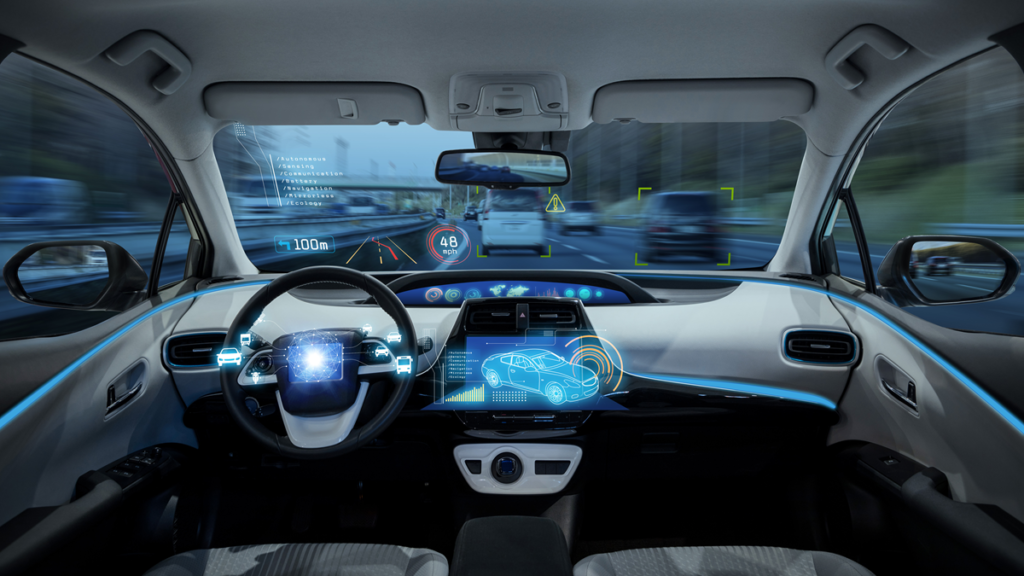With more than 90% of road traffic accidents coming down to human error, the importance of autonomy and its safety benefits cannot be overlooked. As the industry moves into a new era of autonomous driving technologies, safety benchmarks and standards are evolving, forcing car companies to adopt new technologies to keep their cars competitive. IDTechEx‘s report “Autonomous Cars, Robotaxis and Sensors 2024-2044” provides market outlooks for the next twenty years.
Levels of autonomy
Autonomy in vehicles can look different depending on the SAE level, varying from 0 to 5. Level 0 is now largely a thing of the past, with completely unautomated vehicles no longer really being produced. On the other hand, level 5 autonomy is still far ahead in the future, where a human driver becomes simply a passenger, never needing to interfere with the car’s functions. Once level 5 technologies are ready, cars will be made without steering wheels, pedals, or any conventional controls.

Illustration of the levels of autonomous vehicles based on the definition from the Society of Automotive Engineers (SAE).
In the US, more than 50% of vehicles in 2022 had level 2 autonomy, which includes cars having some automated driving features such as adaptive cruise control and lane keep assist. Even though some of these systems are quite advanced, the large majority of level 2 vehicles still require the driver’s attention with both hands on the wheel. Tesla, General Motors, and Ford were leaders in this technology, with all Tesla models being produced with level 2 autonomy. Many major OEMs now have these features as options, if not as standard, alongside automatic emergency braking.
As of 2023, Ford has been allowed to move its level 2+, hands-free BlueCruise technology onto the road in Germany and the UK, but its public use is limited to a few specific stretches of motorway. Meanwhile, Volkswagen has been deploying Mobileye‘s Road Book Technology, using data collected from Mobileye-powered vehicles over many years. This data is used to build community-sourced HD maps, which contribute to more advanced and capable level 2 ADAS systems while paving a route to higher levels of autonomy in the future.
Emerging autonomous features
In some European countries, the US, and China, level 3 autonomy has been emerging for some time, whereby the driver can take their hands off the wheel and their mind off the task of driving under certain conditions. While Honda was the first company to implement level 3 vehicles into the public domain in Japan in 2021, the Mercedes S-Class with level 3 features has now been deployed in Germany and some American states. To keep safety as a top priority, however, vehicles using the features are limited to around 40mph and are required to warn drivers 10 seconds in advance of any need for them to reengage.
Although level 3 technologies still remain at the bleeding edge of consumer automotive tech, members of the public already have access to level 4 transportation in a few cities. Robotaxis use level 4 autonomous driving technology to provide an Uber-like service, only with no one behind the wheel. Currently, level 4 services are limited to a handful of cities across the US and China, but IDTechEx believes there is now a safe and scalable pathway to mass deployment of these vehicles. Despite this, level 4 technology in private vehicles is still a long time out, with the industry and lawmakers needing to get far more comfortable with level 3 vehicles first.
Autonomous trucks
Autonomous Trucks are another example of autonomy hitting the roads. IDTechEx predicts that prices for these vehicles are expected to decrease globally as they become more mainstream over the next 20 years, while sales are predicted to increase exponentially leading up to 2044. As discussed in IDTechEx’s report “Autonomous Trucks 2024-2044: Technologies, Trends, Forecasts“, autonomous trucks could be a solution to ongoing safety concerns, driver management problems, and high operational costs. Drivers in the future can be relieved of states of constant high alertness while driving for long periods of time thanks to automated driving features, while automated safety features like automatic emergency braking will keep the truck aware of its surroundings, helping to prevent collisions.
Autonomous vehicles are seeing constant, steady progress but still face barriers, such as uncertainty around liability when the vehicle is operating driver-free and hesitancy from lawmakers. But persistence will be rewarded, as autonomous vehicles are expected to bring a newfound safety to roads worldwide, ultimately preventing all collisions caused by driver error, however, IDTechEx predicts that it could take 15-20 years for this level of autonomy to become widespread.
For more information, please see the IDTechEx’s report, “Autonomous Cars, Robotaxis and Sensors 2024-2044“.
For the full portfolio of market research available from IDTechEx, please visit www.IDTechEx.com.
About IDTechEx
IDTechEx provides trusted independent research on emerging technologies and their markets. Since 1999, we have been helping our clients to understand new technologies, their supply chains, market requirements, opportunities and forecasts. For more information, contact [email protected] or visit www.IDTechEx.com.


